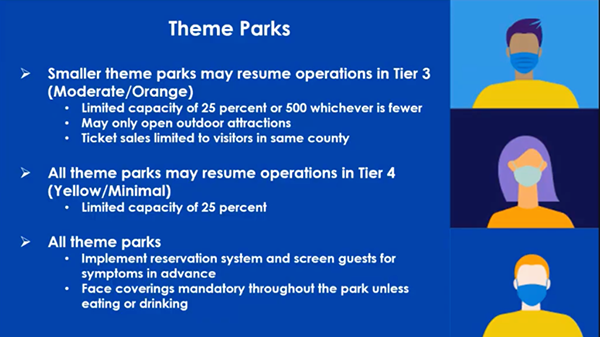Jeff Gritchen/The Orange County Register via AP.
Tom Tapp, California Announces Restrictive Reopening Guidelines For Disneyland, Universal Studios; Less Restrictive Measures For Smaller Parks, Deadline, 20 October 2020
On Monday, California Gov. Gavin Newsom teased the release of reopening rules for theme parks in the state, saying cryptically, “We are going to break up the theme parks…Not just one or two brands, it is many different parts of the theme park industry.”
Well, now we know what that means.
California’s director of Health and Human Services Dr. Mark Ghaly said Tuesday that smaller theme parks can resume operations in the state’s Orange Tier. Capacity will be limited to 25% or 500 visitors, whichever is fewer. Only outdoor attractions may reopen and only to guests who are residents of the same county.
All theme parks — which includes Disneyland in Anaheim and Universal Studios Hollywood — may resume operations in Tier 4, Yellow, which is much further down the road. At that point, the guest limit is 25% across the board and indoor dining establishments can only operate at 25% capacity.
The announcement drew a swift, negative reaction from executives at Disneyland, Universal Studios Hollywood, Legoland and others.
Masks must be worn in all parks at all times, except when visitors are eating or drinking. Reservations will be required for all parks, with temperature checks at the gate.
Orange County, where Disneyland and Knott’s Berry Farm are, is currently in the Red Tier. Los Angeles, home to Universal Studios, is in the most restrictive tier, Purple.

Ghaly said during his press conference today that the state separated parks into two groups: those that have a capacity of 15,000 or fewer guests and those that can welcome more than 15,000.
Asked about the seeming impossibility of large counties moving into the Yellow tier, Ghaly noted that San Francisco had recently moved into yellow.
The state published a lengthy procedure guidance document on Tuesday which, in broad strokes, emphasized physical distancing to the maximum extent possible, use of face coverings by workers (where respiratory protection is not required) and guests, frequent handwashing and regular cleaning and disinfection, and training workers on these and other elements of the COVID-19 prevention plan.
Among the physical distancing recommendations are:
- One-way foot traffic and clear directions to better control the flow of guests throughout the park, especially in certain heavily used and/or narrow throughways
- Plexiglass dividers on switchback lines/queues for attractions and concessions, or close sections of switchback lines/queues to ensure sufficient physical distance between visitors
- Implement timed and/or advanced reservation ticketing systems and pre-assigned seating or activity areas
- Discontinue tours or guided experiences that combine households or individuals from different households into the same tour group (Disneyland’s Haunted House comes to mind here)
- Face coverings are mandatory on attractions and rides throughout the park.
- No indoor lines are allowed for any attraction or ride.
So how were these guidelines developed?
A group from the state went to Florida parks recently came back with excellent guidance on, Ghaly said, “how lines were managed.” But, he said, “the level of mixing even without masks” that state observers saw was of concern.
For those parks that do reopen, “regular inspections will occur,” promised Ghaly.
Ghaly noted that many other states are facing a resurgence of cases but California is not. That was due “in part,” he said, to the fact that the state has “slow and stringent” guidelines to recovery.
Ghaly said that theme parks are a “higher risk setting,” while outdoor sporting events are a “lower risk setting.”

In terms of sports, he said “we are starting with the professional venues,” and that spectators at collegiate games will be allowed down the road.
The major parks and Newsom have been going back and forth for months on the guidelines, with the governor saying the state would be “slow and stringent” in releasing guidelines.
Disney Chairman Bob Iger quit Newsom’s economic task force over a disagreement on reopening.
The California Attractions and Parks Association, which represents theme parks big and small in the state, has issued multiple statements noting that there is not a single documented case of COVID transmission at an amusement park. That’s despite parks in Florida and across the globe having reopened.
With Disneyland, Universal Hollywood, Six Flags and others shuttered, Disney and the Comcast-owned company are tightening their belts and cutting workforce as profits dive.
Under the Red tier: movie theaters and cultural ceremonies can open to 25% capacity or 100 people, whichever is fewer; gyms can open indoors to 10% capacity; childcare, drive-in theaters, family entertainment centers and hotels can open with modifications. Concert venues and live theater and festivals are still prohibited to operate.
Under the Orange tier: movie theaters and restaurants can open to 50% capacity or 200 people, whichever is fewer; bars, nail salons, childcare facilities, church services, day camps, doctors, family entertainment centers, gyms can open with modifications. Concert venues and live theater and festivals are still prohibited to operate.
California’s county-monitoring indicators include testing capacity, how much transmission of the virus is happening in a community, how many people are currently hospitalized for COVID-19, and the capacity of hospitals to care for people with COVID-19 with adequate numbers of available ICU beds and ventilators.

